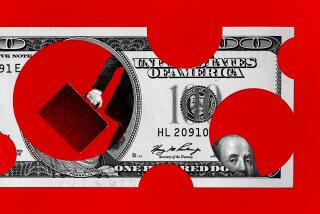New Tax Law Takes Its First Bite This Week
- Share via
Starting later this week, Americans will feel the first effects of the changing federal income tax code, as employers recalculate the amount of cash to withhold from their paychecks.
But for all the aura of historic revision that surrounds the new law, many people will not see a great deal of change, at least not to begin with. The coming year is just the first in a planned two-year tumble of tax rates. The full effect of the changes will not be felt until people pay their taxes for 1988.
According to several tax specialists interviewed, the bottom-line impact of the changes will vary significantly. “For the mass population, it (tax liability) probably will be going down,” predicted Jim Dox, regional tax director for the Ernst & Whinney accounting firm. But he cautioned that many of his clients, who have previously limited their tax bills by making “sophisticated” use of the tax code, may find their debt to the government going up.
Over the next few days, company payroll departments will take the first step toward tax revision, as they begin computing the amount of money to separate out of paychecks, based on new tables from the Internal Revenue Service. For most people, the initial encounter with the changes will be happy, as somewhat less federal tax is taken out of their paychecks.
But the appearance of new wealth could prove illusory. Withholding will have to be adjusted once again during the year, as taxpayers recalculate their tentative tax liability in light of the new law. And, while the 930-page law was touted as a move toward simplifying taxes, this second adjustment will not be entirely simple. The IRS has devised a new, four-page W-4--the form that helps employers decide how much money to withhold from paychecks.
“Filling out the W-4 is going to be more difficult than it has ever been,” said Paul Faranda, vice president of employee relations, benefits and services at Northrop Corp. “It’s going to require a significant amount of work.”
Early Adjustment Advised
Taxpayers have until Oct. 1 to get the chore taken care of, but experts advise people to do it shortly after the new year. Otherwise, they run the risk of building up a substantial debt to the Treasury over a period of several months if not enough money is being set aside.
“I can’t emphasize it enough--people can really get nailed if they’re not careful,” warned Tom Revell, senior vice president and tax director for First Interstate Bancorp. “Those who don’t adjust withholding immediately will run the risk of being under-withheld--and will have to settle with the IRS at a later point in time.”
People will be aided by lower rates and an increase in the personal exemption--the amount taxpayers deduct for themselves and their dependents. But many popular deductions and tax shelters will disappear. As a result, some individuals will make the unpleasant discovery that their taxable income is greater than it used to be.
Areas Curbed or Cut
Areas being tightened or eliminated include deductions for individual retirement accounts, sales tax, consumer interest expenses and the working-spouse deduction, in addition to various shelters exploited by the wealthy.
Typical taxpayers who do not adjust their withholding promptly are likely to face more of an inconvenience than a serious debt, however. Consider the example of a married couple with combined wages of $60,000. Under the old law, they might have had a total of $371 of federal tax taken out of their semimonthly paychecks, said Ellen Y. Sloan, a tax manager in Los Angeles for the Price Waterhouse accounting firm.
With no changes in withholding, a smaller bite of $306 would apply in 1987. But that could prove misleading. Once they redo their W-4 forms, the couple might discover that a greater amount--$341--should be taken out of the paychecks. This sort of situation could prove common, even for those with no increase in gross income. “Depending on your profile,” Sloan said, “you may have taxable income of $40,000 in 1986 that could go up to $45,000 in 1987.”
To spare its employees the headaches of learning belatedly that they owe more than they counted on, many firms are encouraging workers to fill out the new W-4 forms as soon as possible. Atlantic Richfield Corp., for example, plans to distribute the new forms in January.
Reality vs. Projections
Nick Mickas, who manages Arco’s payroll and tax department, said most employees might see more money in their paychecks at first as the new withholding tables take effect. But he would not predict how many people would see the gains evaporate after they project their 1987 obligation in light of the changes. “It’s one thing to talk about withholding from a payroll check and another to talk about what you really owe the federal government,” he said.
Although groaning about taxes has become an American tradition, the income tax is a relatively modern development. It was employed briefly during the Civil War but not introduced for good until 1913. Withholding of federal taxes--or pay-as-you-go taxation--came only with World War II and the need to collect higher taxes for the war effort.
Top rates have wavered over the years, with periods of tax increases often followed by tax cuts. Nonetheless, a recent poll found widespread skepticism that the much-ballyhooed new tax code of 1986 will actually save taxpayers any money.
In the national survey of 5,000 households in September, the Conference Board found that only 15.8% expected lower taxes as a result of the new law, 40.4% anticipated no change and another 43.8% thought their tax bill would increase.
Californians More Skeptical
Californians were a bit more skeptical than the others queried by the New York business research organization, with 45.1% of California respondents saying they expected their tax liability to increase as a consequence of the changes.
“The great feeling is that whenever it comes to taxes you almost always pay more--and I would think that this has shown itself to be true again,” said Fabian Linden, executive director of the Conference Board’s Consumer Research Center.
The skepticism may not be well-founded. In many cases, taxpayers will enjoy savings, albeit moderate ones. Congress’ Joint Committee on Taxation illustrated this in an October report that said, for example, that average taxes for those earning between $20,000 and $30,000 would be $220 less than under the old law by 1988 when the changes are fully in effect. Those earning between $40,000 and $50,000 would save $486. Those earning between $75,000 and $100,000 would save $176.
The impact may or may not be spectacular, but it will be immediate. About 81.5% of taxpayers will owe less in 1987 than they would have under the old law, the congressional researchers found, although they warned that this last statistic may not be scientifically reliable.
After New Year’s Day, the current jumble of 15 tax brackets, ranging from 11% to 50%, will be reshuffled into five categories ranging from 11% to 38.5%. The squeeze continues in 1988, when there will be two basic brackets of 15% and 28%, although technicalities in the law will result in many people paying 33%. “Unless you really take advantage of a lot of tax shelters, the rate cuts do have an effect,” observed Bob Lucke, a manager in Price Waterhouse’s Washington office.
Old Law Comparisons
Under the old law, for example, a two-earner family of three with annual wages of $25,000 that owns a modest home might owe $2,459 for 1987, according to the accounting firm. Under the new tax code, the saving is $196. By 1988, the family will pay $201 less than at the present rate.
If the same household had combined wages of $40,000, owned a larger home and invested $4,000 in an individual retirement account, next year’s bill under the old law could add up to $4,352. Tax revision, however, would mean a $642 saving in 1987 and a $507 saving in 1988, Price Waterhouse found.
Higher Cost for Cheating
As tax rates drop, the cost of cheating will rise. Those found guilty of fraud--in addition to paying off the entire amount they owe--will be fined another 75% of the underpayment plus interest. That’s an increase over the current fine of 50% of the underpayment plus interest. Those who simply fail to pay taxes are in for heftier fines as well. The penalty rises from 0.5% per month of the unpaid amount to 1% per month. (A cap of 25% remains in effect.)
In one respect, at least, the new changes take some of the equality out of the tax code. Until now, the government has compensated those who overpay it by returning their money at the same rate of interest it demands from those who are guilty of underpayments.
Starting next year, however, the equality disappears: Generally, taxpayers whose overpayments are held beyond 45 days after April 15 still will get interest in return. But it will be a full point less than what the IRS demands of those who owe it money.
More to Read
Inside the business of entertainment
The Wide Shot brings you news, analysis and insights on everything from streaming wars to production — and what it all means for the future.
You may occasionally receive promotional content from the Los Angeles Times.










